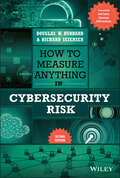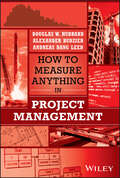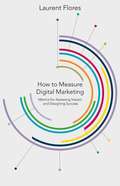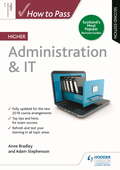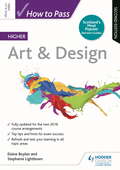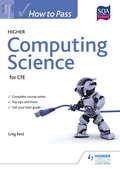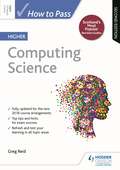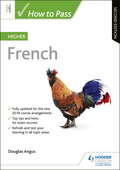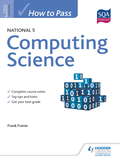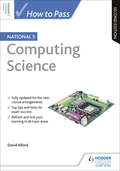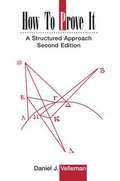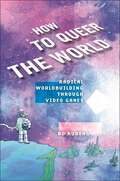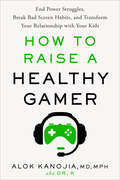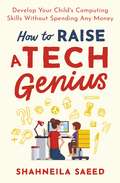- Table View
- List View
How to Measure Anything in Cybersecurity Risk
by Douglas W. Hubbard Richard SeiersenA start-to-finish guide for realistically measuring cybersecurity risk In the newly revised How to Measure Anything in Cybersecurity Risk, Second Edition, a pioneering information security professional and a leader in quantitative analysis methods delivers yet another eye-opening text applying the quantitative language of risk analysis to cybersecurity. In the book, the authors demonstrate how to quantify uncertainty and shed light on how to measure seemingly intangible goals. It's a practical guide to improving risk assessment with a straightforward and simple framework. Advanced methods and detailed advice for a variety of use cases round out the book, which also includes: A new "Rapid Risk Audit" for a first quick quantitative risk assessment. New research on the real impact of reputation damage New Bayesian examples for assessing risk with little data New material on simple measurement and estimation, pseudo-random number generators, and advice on combining expert opinion Dispelling long-held beliefs and myths about information security, How to Measure Anything in Cybersecurity Risk is an essential roadmap for IT security managers, CFOs, risk and compliance professionals, and even statisticians looking for novel new ways to apply quantitative techniques to cybersecurity.
How to Measure Anything in Project Management
by Douglas W. Hubbard Alexander Budzier Andreas Bang LeedUncover common project management myths to improve project success How to Measure Anything in Project Management explains why popular methods for measurement in project management are flawed and describes how to conduct measurements that better inform decisions, reduce project risks, and improve the chance of project success. The authors argue that anything that matters to project management at all is measurable and that these measurements address many of the problems in project management. The authors leverage an exclusive survey on the state-of-the-art of measuring projects, new case studies of things that are seemingly hard to measure and a database, collected by Oxford Global Projects, of thousands of projects in software development, construction, energy, and many other fields, including some of the biggest projects in history. The book is accompanied by a set of useful spreadsheet-based "power tools" that support the more technical aspects of quantifying project risk, forecasting outcomes, and conducting seemingly difficult measurements. In this book, readers will learn: Why many of the methods they have been taught to use are little more than a type of “analysis placebo” Why many popular methods lead to extreme overconfidence in estimates How some of the most important measurements a project could conduct are currently rarely used How to Measure Anything in Project Management earns a well-deserved spot on the bookshelves of managers, executives, auditors, controllers, and consultants seeking to improve project performance through superior measurement methodology.
How to Measure Digital Marketing: Metrics for Assessing Impact and Designing Success
by Laurent FlorésMeasuring the Success of Digital Marketing explains how to determine the success of a digital marketing campaign by demonstrating what digital marketing metrics are as well as how to measure and use them. Including real life case studies and experts viewpoints that help marketers navigate the digital world.
How to Pass Higher Administration & IT, Second Edition (How To Pass - Higher Level)
by Adam Stephenson Anne BradleyExam Board: SQA Level: Higher Subject: Administration & IT First Teaching: August 2018 First Exam: May 2019Get your best grade with comprehensive course notes and advice from Scotland's top experts, fully updated for the latest changes to SQA Higher assessment. How to Pass Higher Administration & IT Second Edition contains all the advice and support you need to revise successfully for your Higher exam. It combines an overview of the course syllabus with advice from top experts on how to improve exam performance, so you have the best chance of success.- Revise confidently with up-to-date guidance tailored to the latest SQA assessment changes - Refresh your knowledge with comprehensive, tailored subject notes- Prepare for the exam with top tips and hints on revision techniques- Get your best grade with advice on how to gain those vital extra marks
How to Pass Higher Administration & IT: Second Edition Epub
by Adam Stephenson Anne BradleyExam Board: SQA Level: Higher Subject: Administration & IT First Teaching: August 2018 First Exam: May 2019Get your best grade with comprehensive course notes and advice from Scotland's top experts, fully updated for the latest changes to SQA Higher assessment. How to Pass Higher Administration & IT Second Edition contains all the advice and support you need to revise successfully for your Higher exam. It combines an overview of the course syllabus with advice from top experts on how to improve exam performance, so you have the best chance of success.- Revise confidently with up-to-date guidance tailored to the latest SQA assessment changes - Refresh your knowledge with comprehensive, tailored subject notes- Prepare for the exam with top tips and hints on revision techniques- Get your best grade with advice on how to gain those vital extra marks
How to Pass Higher Art & Design, Second Edition (How To Pass - Higher Level)
by Elaine Boylan Stephanie LightbownExam Board: SQA Level: Higher Subject: Art & Design First Teaching: August 2018 First Exam: May 2019Get your best grade with comprehensive course notes and advice from Scotland's top experts, fully updated for the latest changes to SQA Higher assessment. How to Pass Higher Art & Design Second Edition contains all the advice and support you need to revise successfully for your Higher exam. It combines an overview of the course syllabus with advice from top experts on how to improve exam performance, so you have the best chance of success.- Revise confidently with up-to-date guidance tailored to the latest SQA assessment changes - Refresh your knowledge with comprehensive, tailored subject notes- Prepare for the exam with top tips and hints on revision techniques- Get your best grade with advice on how to gain those vital extra marks
How to Pass Higher Art & Design: Second Edition Epub
by Elaine Boylan Stephanie LightbownExam Board: SQA Level: Higher Subject: Art & Design First Teaching: August 2018 First Exam: May 2019Get your best grade with comprehensive course notes and advice from Scotland's top experts, fully updated for the latest changes to SQA Higher assessment. How to Pass Higher Art & Design Second Edition contains all the advice and support you need to revise successfully for your Higher exam. It combines an overview of the course syllabus with advice from top experts on how to improve exam performance, so you have the best chance of success.- Revise confidently with up-to-date guidance tailored to the latest SQA assessment changes - Refresh your knowledge with comprehensive, tailored subject notes- Prepare for the exam with top tips and hints on revision techniques- Get your best grade with advice on how to gain those vital extra marks
How to Pass Higher Computing Science for CfE
by Greg ReidGet your best grade with the SQA endorsed guide to Higher Computing Science for CfE.This book contains all the advice and support you need to revise successfully for your Higher (for CfE) exam. It combines an overview of the course syllabus with advice from a top expert on how to improve exam performance, so you have the best chance of success.· Refresh your knowledge with complete course notes· Prepare for the exam with top tips and hints on revision techniques· Get your best grade with advice on how to gain those vital extra marks
How to Pass Higher Computing Science, Second Edition (How To Pass - Higher Level)
by Greg ReidExam Board: SQA Level: Higher Subject: Computing Science First Teaching: August 2018 First Exam: May 2019 Get your best grade with comprehensive course notes and advice from Scotland's top experts, fully updated for the latest changes to SQA Higher assessment. How to Pass Higher Computing Science Second Edition contains all the advice and support you need to revise successfully for your Higher exam. It combines an overview of the course syllabus with advice from a top expert on how to improve exam performance, so you have the best chance of success.- Revise confidently with up-to-date guidance tailored to the latest SQA assessment changes - Refresh your knowledge with comprehensive, tailored subject notes- Prepare for the exam with top tips and hints on revision techniques- Get your best grade with advice on how to gain those vital extra marks
How to Pass Higher Computing Science: Second Edition Epub (How To Pass - Higher Level Ser.)
by Greg ReidExam Board: SQA Level: Higher Subject: Computing Science First Teaching: August 2018 First Exam: May 2019 Get your best grade with comprehensive course notes and advice from Scotland's top experts, fully updated for the latest changes to SQA Higher assessment. How to Pass Higher Computing Science Second Edition contains all the advice and support you need to revise successfully for your Higher exam. It combines an overview of the course syllabus with advice from a top expert on how to improve exam performance, so you have the best chance of success.- Revise confidently with up-to-date guidance tailored to the latest SQA assessment changes - Refresh your knowledge with comprehensive, tailored subject notes- Prepare for the exam with top tips and hints on revision techniques- Get your best grade with advice on how to gain those vital extra marks
How to Pass Higher French, Second Edition (How To Pass - Higher Level)
by Douglas AngusExam Board: SQA Level: Higher Subject: French First Teaching: August 2018 First Exam: May 2019Get your best grade with comprehensive course notes and advice from Scotland's top experts, fully updated for the latest changes to SQA Higher assessment. How to Pass Higher French Second Edition contains all the advice and support you need to revise successfully for your Higher exam. It combines an overview of the course syllabus with advice from a top expert on how to improve exam performance, so you have the best chance of success.- Revise confidently with up-to-date guidance tailored to the latest SQA assessment changes - Refresh your knowledge with comprehensive, tailored subject notes- Prepare for the exam with top tips and hints on revision techniques- Get your best grade with advice on how to gain those vital extra marks
How to Pass Higher French: Second Edition Epub
by Douglas AngusExam Board: SQA Level: Higher Subject: French First Teaching: August 2018 First Exam: May 2019Get your best grade with comprehensive course notes and advice from Scotland's top experts, fully updated for the latest changes to SQA Higher assessment. How to Pass Higher French Second Edition contains all the advice and support you need to revise successfully for your Higher exam. It combines an overview of the course syllabus with advice from a top expert on how to improve exam performance, so you have the best chance of success.- Revise confidently with up-to-date guidance tailored to the latest SQA assessment changes - Refresh your knowledge with comprehensive, tailored subject notes- Prepare for the exam with top tips and hints on revision techniques- Get your best grade with advice on how to gain those vital extra marks
How to Pass National 5 Computing Science
by Frank FrameGet your best grade with the SQA endorsed guide to National 5 Computing Science.This book contains all the advice and support you need to revise successfully for your National 5 exam. It combines an overview of the course syllabus with advice from a top expert on how to improve exam performance, so you have the best chance of success. Refresh your knowledge with complete course notes Prepare for the exam with top tips and hints on revision technique Get your best grade with advice on how to gain those vital extra marks
How to Pass National 5 Computing Science, Second Edition
by David AlfordExam Board: SQALevel: National 5Subject: Computing ScienceFirst Teaching: September 2017First Exam: Summer 2018Get your best grade with the SQA endorsed guide to National 5 Computing Science.Fully updated to account for the removal of Unit Assessments and the changes to the National 5 exam, this book contains all the advice and support you need to revise successfully. It combines an overview of the course syllabus with advice from a top expert on how to improve exam performance, so you have the best chance of success.- Refresh your knowledge with complete course notes- Prepare for the exam with top tips and hints on revision technique- Get your best grade with advice on how to gain those vital extra marks
How to Pass National 5 Computing Science: Second Edition
by David AlfordExam Board: SQALevel: National 5Subject: Computing ScienceFirst Teaching: August 2017First Exam: May 2018Get your best grade with the SQA endorsed guide to National 5 Computing Science.Fully updated to account for the removal of Unit Assessments and the changes to the National 5 exam, this book contains all the advice and support you need to revise successfully. It combines an overview of the course syllabus with advice from a top expert on how to improve exam performance, so you have the best chance of success.- Refresh your knowledge with complete course notes- Prepare for the exam with top tips and hints on revision technique- Get your best grade with advice on how to gain those vital extra marks
How to Photograph Absolutely Everything: Successful Pictures from Your Digital Camera
by Tom AngThis paperback edition of How To Photograph Absolutely Everything by renowned photographer, author, and broadcaster Tom Ang, delivers exactly what the title promises. Avoiding intimidating technical jargon, he explains the basic elements of photography - light, color, composition, and focus - then goes on to show how to make them work for you. From still lifes to children's parties, thunderstorms to sunsets, close-ups to panoramas, every photographic subject, technique, and challenge is covered. Using step-by-step photographs and instructions, Tom shows you how to take the best possible picture in any situation. Want to photograph city lights at night, animals in action, a family portrait? Tom makes it easy. Employing a user-friendly "recipe" formula, he shows you the best approach for each subject, gives expert tips on improving an image, and tells you how to set up your camera - so you really can't go wrong. Inspiring galleries at the end of each section describe alternative techniques to try for every subject. There are also tips on basic post-production, showing how to crop, improve color and contrast, and remove unwanted elements of an image. How to Photograph Absolutely Everything guarantees to make a better, more confident photographer of absolutely everyone who reads it.
How to Photograph Food
by Beata LubasFood photography is a rapidly-growing genre, and whether you're a food blogger looking to take your presentation to the next level, or a professional photographer keen to expand into this lucrative market, this book has everything you need to make it all a piece of cake.Using the techniques she has developed through years of professional success, Beata Lubas will teach you how to anticipate your clients' needs, articulate your own style, and skillfully manufacture sumptuous shots that leap from the page. Learn how to tell food stories using light, colour and shape to evoke atmosphere. Discover methods for shaping natural light to produce magical images in any environment. Combine styling tricks and camera skills to create sensational compositions.With clear, concise and comprehensive instruction to suite every skill level, this book takes you through all the stages involved in creating incredible food photography. So much more than just a guide to photographing food, this is a must-read manual for every photographer working with natural light.
How to Photograph Food: Compose, Shoot, and Edit Appetizing Images
by Beata LubasFor amateurs and pros looking to add to their portfolios, How to Photograph Food makes food photography a piece of cake!How to Photograph Food is the gorgeous, informative photography book you didn't know you needed. For budding photographers and social media personalities, the perfect image has never been easier to capture, and How to Photograph Foodputs it all within reach. Chapters include: GearLightingFrame and BalanceFood StylingPhoto EditingThinking like a ProYou'll learn the essential equipment, how to keep food looking good on a shoot, how to work with props, managing lighting, and much more, all from a skilled photographer and teacher. With only a digital camera and a little practice, you'll be able to turn out images with great contrast, balance, and appeal that look as good as they taste.
How to Play Video Games (User's Guides to Popular Culture #1)
by Nina B. Huntemann Matthew Thomas PayneForty original contributions on games and gaming culture What does Pokémon Go tell us about globalization? What does Tetris teach us about rules? Is feminism boosted or bashed by Kim Kardashian: Hollywood? How does BioShock Infinite help us navigate world-building?From arcades to Atari, and phone apps to virtual reality headsets, video games have been at the epicenter of our ever-evolving technological reality. Unlike other media technologies, video games demand engagement like no other, which begs the question—what is the role that video games play in our lives, from our homes, to our phones, and on global culture writ large? How to Play Video Games brings together forty original essays from today’s leading scholars on video game culture, writing about the games they know best and what they mean in broader social and cultural contexts. Read about avatars in Grand Theft Auto V, or music in The Legend of Zelda: Ocarina of Time. See how Age of Empires taught a generation about postcolonialism, and how Borderlands exposes the seedy underbelly of capitalism. These essays suggest that understanding video games in a critical context provides a new way to engage in contemporary culture. They are a must read for fans and students of the medium.
How to Profit from Auctions
by Fiona ShoopTV Programs like Bargain Hunt and Cash in the Attic have increased the publics interest in attending auctions. This invaluable guide shows all the tricks of the trade from looking for costly scratches hidden under labels when buying to negotiating for a better rate when selling, as well as how to arrange free collection and getting the best from your local auction house. Whether you want to learn how to bid so youre seen by the auctioneer or want to ensure your commission bid stands a better chance, antiques expert, Fiona Shoops advice could make you thousands. Contains a glossary to decipher common auction terms, as well as a detailed county by county auction directory with over 600 auctions listed.
How to Prove It: A Structured Approach (Second Edition)
by Daniel J. VellemanThis book helps students to develop deductive reasoning ability in general and to learn the underlying principles involved in the construction of proofs by focusing on "structured proving."
How to Queer the World: Radical Worldbuilding through Video Games
by Bo RubergWhat video games teach us about building a more inclusive worldWhat does it mean to build a world? Worldbuilding is traditionally understood as an expression of storytelling across media forms. Yet, as video games show us, worldbuilding does not necessarily need to center narrative elements. Instead, new worlds can allow us to reimagine existing structures, conventions, and constants. Doing so gives us the tools to queer the world around us.How to Queer the World argues that video games provide us with keen insight into worldbuilding. With these insights come a new understanding of the ever-elusive ideals of queer worldmaking. Video games challenge us to address how worlds are built through underlying systems rather than surface-level representation. They also offer opportunities to envision alternate and queer ways of living, loving, desiring, and being. Each of the chapters in this book presents a close reading of a video game that illustrates one way of building worlds and encoding them with meaning, focusing on elements of digital media often overlooked as technical rather than cultural.From the design of game mechanics and user interfaces to the use of graphics software and physics simulations, Bo Ruberg argues that these aspects of video games represent a critical toolkit for seeing the work of worldbuilding differently—in video games and beyond. Simultaneously, each of these video games models an approach to what Ruberg terms “queer worldbuilding.” Queer worldbuilding radically remakes the world by destabilizing the fundamental logics of our own universe: who we are, what we can do, how our bodies move, and how we exist within time and space.
How to Raise a Healthy Gamer: End Power Struggles, Break Bad Screen Habits, and Transform Your Relationship with Your Kids
by Alok KanojiaA former gamer and Harvard-trained psychiatrist offers a proven, tested plan to help parents define, set, and reinforce healthy boundaries around video games and help kids who have developed an addiction to gaming.&“I highly recommend this calm, structured, and nurturing approach to better and less screen use.&”—Tina Payne Bryson, PhD, New York Times bestselling coauthor of The Whole-Brain Child and No-Drama DisciplineHow much should I let them play? How do I get them to be interested in anything else?! When it comes to family rules around video games, most parents are at a loss. After all, our technologically invasive world is something previous generations didn&’t have to wrestle with, so we have no model for how to guide our families through the rapidly changing landscape, no blueprint for setting healthy gaming boundaries and keeping them in place. A former Harvard Medical School instructor and one of the foremost experts on video game psychology, Dr. Alok Kanojia—known as &“Dr. K&” to his millions of followers—has firsthand knowledge of this modern issue: He needed professional help to break his own gaming habits in college, an experience that fueled his interest in learning how to help others. Drawing on Dr. K&’s professional specialization in working with people of all ages and varying degrees of addiction, and the most recent research from neuroscience and psychology, How to Raise a Healthy Gamer teaches parents a new skill set for negotiating gaming culture and offers solutions rooted in the science of treating addiction, including: • An eight-week, step-by-step road map for setting, enforcing, and troubleshooting healthy gaming boundaries.• Advice on how to react when your child becomes irritable, rude, or seemingly directionless.• Essential communication strategies for reaching kids who have developed a serious gaming problem.• The neuroscientific and psychological reasons that children gravitate to video games and how to help them meet these needs in real life.• Insights and advice on dealing with behavioral issues that often accompany game use: ADHD, spectrum disorders, and substance abuse. Whether your goal is to prepare your child for a healthy relationship to technology or to curb unhealthy amounts of time spent gaming, How to Raise a Healthy Gamer will help you better understand, communicate with, and—ultimately—empower your gaming enthusiast to live their best life.
How to Raise a Tech Genius: Develop Your Child's Computing Skills Without Spending Any Money
by Shahneila SaeedTeach computing concepts without computers! How to Raise a Tech Genius makes the computing curriculum accessible for parents and families.We live in a digital world - one in which our children are surrounded by technology. It's a part of their lives in a way that even the most tech-savvy adults aren't fully able to comprehend. What we do know is that the workplace of tomorrow will require our children to harness the power behind the technology, to be able to understand key concepts and apply them. Logical reasoning, creativity and problem solving are skills that are becoming increasingly essential in the world of work. How can we best prepare our children to enter this world? How to Raise a Tech Genius is a practical book that assumes no prior knowledge or understanding of computing and enables parents to learn skills and concepts alongside their children. The quick, easy and fun fifteen-minute activities within the book have been developed using first-hand teaching expertise and are fully mapped to the computing curriculum taught in schools. From a deck of playing cards to the story books on your bookshelf or even the contents of your fridge, How to Raise a Tech Genius uses everyday objects that can be found around your home to illustrate core computer science concepts. Children and adults alike will enjoying playing games while developing their algorithmic thinking and logical reasoning skills. This book demystifies the computing curriculum for adults, showing parents a whole new side of computing, coding and technology so that they can help their child become a computing genius!
How to Raise a Tech Genius: Develop Your Child's Computing Skills Without Spending Any Money
by Shahneila SaeedTeach computing concepts without computers! How to Raise a Tech Genius makes the computing curriculum accessible for parents and families.We live in a digital world - one in which our children are surrounded by technology. It's a part of their lives in a way that even the most tech-savvy adults aren't fully able to comprehend. What we do know is that the workplace of tomorrow will require our children to harness the power behind the technology, to be able to understand key concepts and apply them. Logical reasoning, creativity and problem solving are skills that are becoming increasingly essential in the world of work. How can we best prepare our children to enter this world? How to Raise a Tech Genius is a practical book that assumes no prior knowledge or understanding of computing and enables parents to learn skills and concepts alongside their children. The quick, easy and fun fifteen-minute activities within the book have been developed using first-hand teaching expertise and are fully mapped to the computing curriculum taught in schools. From a deck of playing cards to the story books on your bookshelf or even the contents of your fridge, How to Raise a Tech Genius uses everyday objects that can be found around your home to illustrate core computer science concepts. Children and adults alike will enjoying playing games while developing their algorithmic thinking and logical reasoning skills. This book demystifies the computing curriculum for adults, showing parents a whole new side of computing, coding and technology so that they can help their child become a computing genius!
